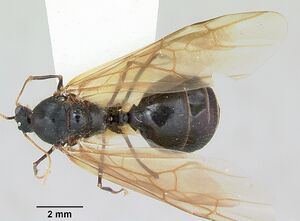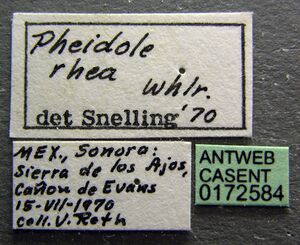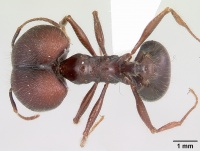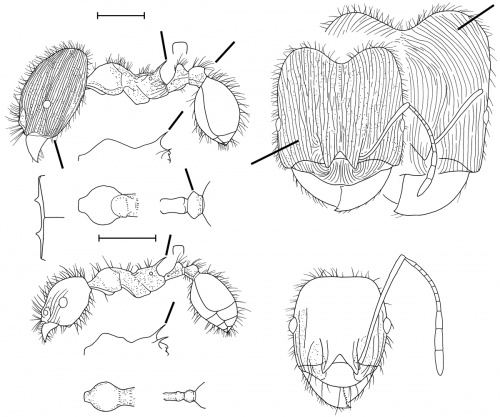Pheidole rhea
| Pheidole rhea | |
|---|---|

| |
| Scientific classification | |
| Kingdom: | Animalia |
| Phylum: | Arthropoda |
| Class: | Insecta |
| Order: | Hymenoptera |
| Family: | Formicidae |
| Subfamily: | Myrmicinae |
| Tribe: | Attini |
| Genus: | Pheidole |
| Species: | P. rhea |
| Binomial name | |
| Pheidole rhea Wheeler, W.M., 1908 | |
This species is found on plateaus and among foothills at the base of mountains across a wide elevational range, from 1100 to 2100 m, with an apparent preference for the lower end (Creighton 1950: 168). According to Stefan Cover (personal communication), it “forms enormous colonies surmounted by sloppy craters or under rocks, chiefly on open, rocky slopes. Seeds are harvested in large quantities, but the ants are active predators as well. Mature colonies have well-developed trunk-trail systems. Minors and medias forage, but large majors and supermajors are seldom seen outside the nests. The ants are aggressive, and all size classes actively defend the nest.” (Wilson 2003)
Identification
This is a large, polymorphic species, in which the propodeal spines of both the major and minor are unusually long and sharp. The gaster is rounded anteriorly, where it connects to the postpetiole. The entire dorsum of the head is covered with striae, which diverge towards the posterior lateral lobes. These striae may form concentric whorls on the posterior lateral lobes of the largest workers. The apex of the petiole is relatively sharp, and may be bidentate in the largest workers. The lateral connules are well developed. (Mackay and Mackay 2002)
Also see the description in the nomenclature section.
Keys including this Species
Distribution
Southern Arizona, New Mexico and south into Mexico.
Latitudinal Distribution Pattern
Latitudinal Range: 34.156971° to 22.520422°.
| North Temperate |
North Subtropical |
Tropical | South Subtropical |
South Temperate |
- Source: AntMaps
Distribution based on Regional Taxon Lists
Nearctic Region: United States (type locality).
Neotropical Region: Mexico.
Distribution based on AntMaps
Distribution based on AntWeb specimens
Check data from AntWeb
Countries Occupied
| Number of countries occupied by this species based on AntWiki Regional Taxon Lists. In general, fewer countries occupied indicates a narrower range, while more countries indicates a more widespread species. |

|
Estimated Abundance
| Relative abundance based on number of AntMaps records per species (this species within the purple bar). Fewer records (to the left) indicates a less abundant/encountered species while more records (to the right) indicates more abundant/encountered species. |

|
Habitat
Upland open and grassy slopes in mountain foothills. Nests are found on plateaus or in foothills at the bases of mountains, from 1100 - 2200 meters. (Mackay and Mackay 2002)
Biology
This species nests in the soil, and nests can be very large. They are not commonly collected in the United States, and are much more common in México. The majors have such heavy heads, that they become “stuck” in a position with the heads down and the remainder of the body and legs kicking in the air! (Mackay and Mackay 2002)
Castes
This species is one of a small number of Pheidole species that has three worker castes.
Gordon et al. (2017) examined behavioral, morphological and neurological differences among the three worker castes in a large (~30,000 workers) laboratory colony. They found: differentiation in behavior and brain anatomy between minor workers and soldier groups but not between soldiers and supersoldiers in P. rhea. Although three worker groups can be distinguished by body size and head allometry (Huang and Wheeler 2011), the lack of further distinction between soldier and supersoldier groups in behavior and neuroanatomy, as well as body shape, does not provide evidence of selection for discrete, size-related social roles and correlated divergence in neural phenotypes in this species. The extensive behavioral repertoire overlap between soldiers and supersoldiers suggests that workers in these size classes are not performing qualitatively different tasks but may instead vary in the frequency, efficacy, or efficiency with which acts are performed. If soldier and supersoldier workers perform qualitatively similar tasks, we expect their sensory, motor, and cognitive demands to be similar, resulting in conserved brain phenotypes.
They speculated that the two larger worker castes are specialized for handling and processing different sized seeds. These putative behavioral differences were not addressed in the design of their laboratory colony observations.
Worker
Minor
Images from AntWeb
   
| |
| Worker. Specimen code casent0102893. Photographer Jen Fogarty, uploaded by California Academy of Sciences. | Owned by CAS, San Francisco, CA, USA. |
   
| |
| Worker (major/soldier). Specimen code casent0172583. Photographer April Nobile, uploaded by California Academy of Sciences. | Owned by LACM, Los Angeles, CA, USA. |
Major
Images from AntWeb
   
| |
| Worker (major/soldier). Specimen code casent0102892. Photographer Jen Fogarty, uploaded by California Academy of Sciences. | Owned by CAS, San Francisco, CA, USA. |
   
| |
| Worker (major/soldier). Specimen code casent0103489. Photographer April Nobile, uploaded by California Academy of Sciences. | Owned by LACM, Los Angeles, CA, USA. |
Queen
Images from AntWeb
   
| |
| Queen (alate/dealate). Specimen code casent0103488. Photographer April Nobile, uploaded by California Academy of Sciences. | Owned by LACM, Los Angeles, CA, USA. |
Male
Images from AntWeb
    
| |
| Male (alate). Specimen code casent0172584. Photographer April Nobile, uploaded by California Academy of Sciences. | Owned by LACM, Los Angeles, CA, USA. |
Additional images can be found here.
Nomenclature
The following information is derived from Barry Bolton's Online Catalogue of the Ants of the World.
- rhea. Pheidole rhea Wheeler, W.M. 1908e: 452 (q.) U.S.A. Smith, M.R. 1943c: 7 (s.w.). Combination in P. (Macropheidole): Smith, M.R. 1943c: 5. Junior synonym of fimbriata: Wheeler, W.M. 1915b: 403; Emery, 1921f: 81. Revived from synonymy: Smith, M.R. 1943c: 7. See also: Gregg, 1949a: 70; Creighton, 1950a: 168; Wilson, 2003: 594.
Unless otherwise noted the text for the remainder of this section is reported from the publication that includes the original description.
Description
From Wilson (2003): DIAGNOSIS A giant species, reddish to dark brown, tentatively placed in the pilifera group because of the bidentate hypostoma and presence of a supermajor, but with overall appearance similar to some species of the fallax group. Trimorphic, with major, supermajor, and minor castes, as illustrated. Also distinguished as follows.
Major: head completely covered everywhere except on frontal triangle by dense longitudinal carinulae; promesonotum smoothly convex in both side and dorsal-oblique views; propodeal spines very long; posterior face of propodeum descends vertically; postpetiole diamond-shaped from above. Supermajor: propodeum descends vertically; postpetiole diamond-shaped from above; cephalic sculpturing as in major, except that the carinulae of the dorsal face behind the level of the eye curve inward toward the cephalic midline.
Minor: very long propodeal spines, as illustrated.
MEASUREMENTS (mm) All castes measured are from Stratton, Santa Catalina Mts., Arizona.
- Supermajor: HW 3.86, HL 4.04, SL 1.68, EL 0.38, PW 1.38.
- Major: HW 2.52, HL 2.76, SL 1.40, EL 0.26, PW 1.04. Minor: HW 0.86, HL 0.96, SL 1.06, EL 0.16, PW 0.58.
COLOR Major and minor: body light reddish brown, except for the gaster, which is a slightly contrasting dark reddish brown.
Figure. Upper: major, with partial view of supermajor head at far right. Lower: minor. ARIZONA: Stratton, Santa Catalina Mts., northeast of Tucson. Scale bars = 1 mm.
Type Material
Nogales, Arizona. Unique holotype queen: Department of Entomology Collection, Cornell University, Ithaca, New York. - as reported in Wilson (2003)
Etymology
NL rhea, a South American genus of ostrich-like birds, allusion unknown. (Wilson 2003)
Worker Morphology
 Explore: Show all Worker Morphology data or Search these data. See also a list of all data tables or learn how data is managed.
Explore: Show all Worker Morphology data or Search these data. See also a list of all data tables or learn how data is managed.
- Caste: trimorphic
References
- Wilson, E. O. 2003. Pheidole in the New World: A dominant, hyperdiverse ant genus. Harvard University Press, Cambridge, MA. (page 594, fig. major, minor described)
- Alatorre-Bracamontes, C.E., Vásquez-Bolaños, M. 2010. Lista comentada de las hormigas (Hymenoptera: Formicidae) del norte de México. Dugesiana 17(1): 9-36.
- Creighton, W. S. 1950a. The ants of North America. Bulletin of the Museum of Comparative Zoology 104: 1-585
- Emery, C. 1921c. Hymenoptera. Fam. Formicidae. Subfam. Myrmicinae. [part]. Genera Insectorum 174A:1-94 94: 1-94 + 7 (page 81, Junior synonym of fimbriata)
- Gordon, D. G., I. Ilies, and J. F. A. Traniello. 2017. Behavior, brain, and morphology in a complex insect society: trait integration and social evolution in the exceptionally polymorphic ant Pheidole rhea. Behavioral Ecology and Sociobiology. 71. doi:10.1007/s00265-017-2396-z
- Gregg, R. E. 1949a. A note on Pheidole (Macropheidole) rhea Wheeler (Hymenoptera: Formicidae). Psyche. 56:70-73.
- Guerrero, R.J., García, E., Fernández, F. 2022. The Pheidole Westwood, 1839 ants (Formicidae: Myrmicinae) in Colombia: new records including two species with remarkable morphology. Zootaxa 5154 (3): 319-332 (doi:10.11646/zootaxa.5154.3.5).
- Jansen, G., Savolainen, R. 2010. Molecular phylogeny of the ant tribe Myrmicini (Hymenoptera: Formicidae). Zoological Journal of the Linnean Society 160(3), 482–495 (doi:10.1111/j.1096-3642.2009.00604.x).
- Penick, C.A., Copple, R.N., Mendez, R.A. & Smith, A.A. 2012. The Role of Anchor-Tipped Larval Hairs in the Organization of Ant Colonies. PLoS ONE 7(7): e41595 (doi:10.1371/journal.pone.0041595).
- Smith, M. R. 1943c. Pheidole (Macropheidole) rhea Wheeler, a valid species (Hymenoptera: Formicidae). Proc. Entomol. Soc. Wash. 45: 5-9 (page 7, Revived from synonymy, soldier, worker described, Combination in P. (Macropheidole))
- Wheeler, W. M. 1908h. The ants of Texas, New Mexico and Arizona. (Part I.). Bull. Am. Mus. Nat. Hist. 24: 399-485. (page 452, queen described)
- Wheeler, W. M. 1915b. Some additions to the North American ant-fauna. Bull. Am. Mus. Nat. Hist. 34: 389-421 (page 403, Junior synonym of fimbriata)
References based on Global Ant Biodiversity Informatics
- Alatorre-Bracamontes, C.E. and M Vasquez-Bolanos. 2010. Lista comentada de las hormigas (Hymenoptera: Formicidae) del norte de México. Dugesiana 17(1):9-36
- Boulton A.M. and P.S. Ward. 2002. Ants. Chapter 5 in A New island Biogeography of the Sea of Cortes. T.J. Case, M.L. Cody and E. Ezcurra. Oxford university Press.
- Cover S. P., and R. A. Johnson. 20011. Checklist of Arizona Ants. Downloaded on January 7th at http://www.asu.edu/clas/sirgtools/AZants-2011%20updatev2.pdf
- Dattilo W. et al. 2019. MEXICO ANTS: incidence and abundance along the Nearctic-Neotropical interface. Ecology https://doi.org/10.1002/ecy.2944
- Fernandes, P.R. XXXX. Los hormigas del suelo en Mexico: Diversidad, distribucion e importancia (Hymenoptera: Formicidae).
- Johnson R. Personnal Database. Accessed on February 5th 2014 at http://www.asu.edu/clas/sirgtools/resources.htm
- Kempf, W.W. 1972. Catalago abreviado das formigas da regiao Neotropical (Hym. Formicidae) Studia Entomologica 15(1-4).
- Mackay W. P. and Mackay, E. E. 2002. The ants of New Mexico (Hymenoptera: Formicidae). Lewiston, New York: Edwin Mellen Press, 400 pp.
- Pape R. B., and B. M. O'connor. 2014. Diversity and ecology of the macro-invertebrate fauna (Nemata and Arthropoda) of Kartchner Caverns, Cochise County, Arizona, United States of America. Checklist 10(4): 761-794.
- Vasquez-Bolanos M. 2011. Checklist of the ants (Hymenoptera: Formicidae) from Mexico. Dugesiana 18(1): 95-133.
- Vásquez-Bolaños M. 2011. Lista de especies de hormigas (Hymenoptera: Formicidae) para México. Dugesiana 18: 95-133
- Ward P.S. and A.M. Boulton. 2002. Checklist of the ants of the Gulf of California Islands. In Island Biogeography of the sea of Cortes. T.J. Case, M.L. Cody and E. Ezcurra Editors. 690 pp.
- Wilson, E.O. 2003. Pheidole in the New World: A Dominant, Hyperdiverse Genus. Harvard University Press


